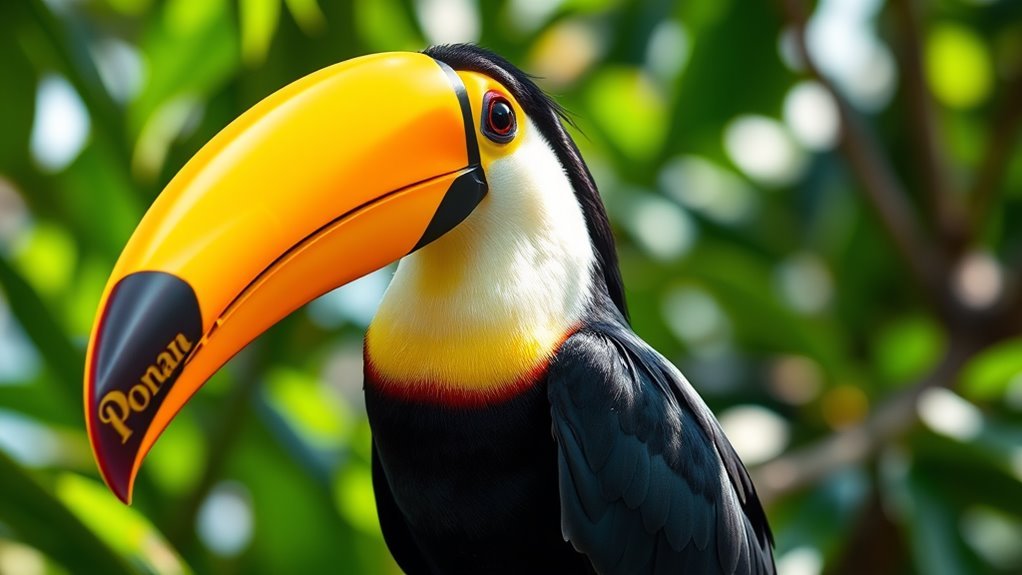The Science Behind Toucans’ Large Beaks
Toucans have large beaks that serve important functions in their daily lives. These beaks are lightweight and made of keratin. They help toucans find food, regulate body temperature, and communicate with each other. Each of these roles is vital for the toucans' survival in tropical environments.
The size and shape of the beak allow toucans to reach fruit and other food sources that are high in trees. The beak also helps with cooling the toucan's body by releasing heat. Furthermore, toucans use their beaks during social interactions. They often display their beaks to communicate with each other.
Understanding these functions helps us appreciate how toucans thrive in their habitats. The unique features of their beaks play a significant role in their overall success.
Key Takeaways
- Toucan beaks are made of lightweight keratin, providing strength and flexibility for foraging diverse food sources in their habitats.
- Larger beaks enable access to fruits and insects, enhancing feeding efficiency compared to smaller bird species.
- The hollow structure of toucan beaks aids in thermoregulation, helping to cool the bird in hot tropical climates.
- Brightly colored beaks serve as social signals, indicating status and attracting mates within toucan groups.
- Beaks also assist in vocal communication and emotional expression, facilitating social interactions among toucans.
Evolution of the Toucan Beak

As toucans evolved, their large beaks became essential tools for survival in the canopies of Central and South America.
These beaks vary in size and shape, helping toucans adapt to different environments. The beaks allow them to easily reach fruits and insects that other birds can't access.
Toucans also use their colorful beaks in social interactions. Bright beaks attract mates and help strengthen relationships within their groups.
Over time, these adaptations have led to different toucan species, each suited to its habitat.
Studying toucans offers insight into how physical traits connect with environmental needs, showing how nature shapes life in tropical ecosystems.
Structural Composition of Toucan Beaks
Toucan beaks are interesting structures made mainly of keratin, a lightweight protein found in human hair and nails.
This beak design combines strength and flexibility, allowing toucans to eat a variety of foods. Keratin's properties help reduce weight, so the beak doesn't interfere with flying or daily activities.
The hollow shape of the beak also aids in regulating temperature, which is important in tropical environments.
These features make toucan beaks not only eye-catching but also well-suited to the birds' needs. Understanding how these beaks are made enhances your appreciation for toucans and their unique adaptations.
The Role of Beak Size in Foraging

Beak size significantly impacts a toucan's ability to find and access food. Toucans with larger beaks can grip, manipulate, and extract fruits and insects more effectively.
This size advantage allows them to reach food that smaller birds can't access. Their beaks help them eat larger fruits and open tough structures like branches and bark.
This adaptability broadens their diet and lets them thrive in various habitats. Thus, the size and shape of a toucan's beak are key to its foraging success and survival in its ecosystem.
Thermoregulation: Cooling Down With a Beak
Toucans use their large beaks to help cool down in hot tropical climates. The beak has a big surface area that helps them release heat.
When the air flows over their beaks, toucans can lower their body temperature. Research shows that this method prevents toucans from overheating on hot days.
This ability helps them survive in their environment and highlights how their anatomy fits their habitat.
Understanding how toucans regulate temperature makes us appreciate their unique features and how they live in challenging conditions.
Social Signaling and Communication

Toucans use their beaks for heat regulation and communication. The size and color of a toucan's beak can show its social status. A larger or brighter beak often indicates a higher rank in the group.
Toucans have varied vocalizations that help them identify other individuals and mark their territories.
- A large beak can signal dominance.
- Unique sounds help identify toucans and their areas.
- Beak movements can express feelings and intentions.
These behaviors help toucans build relationships and maintain order in their social groups.
Learning about these interactions shows how toucans adapt and thrive within their communities. This understanding adds to our appreciation of their social lives.
Adaptations to Habitat and Diet
Toucans adapt well to their environment and diet. They live in tropical rainforests, which offer many food options.
Their large beaks help them eat fruits and insects that other birds can't reach. This ability allows them to get enough food.
Toucans also help the ecosystem by spreading seeds, which aids in forest growth. Their ability to adapt shows how they survive and highlights the connections among different species in their habitat.
Understanding these relationships helps us appreciate nature more.
Predation and Defense Mechanisms
Toucans encounter many predators in their rainforest home. They use several defense methods to survive.
- Vocal communication: Toucans make loud calls to warn others about threats, prompting quick reactions from their group.
- Camouflage: Their bright feathers can blend with colorful fruits and flowers, helping them avoid detection.
- Mobility: Toucans can move swiftly through tree branches, allowing them to escape danger quickly.
These strategies help toucans evade predators, ensuring their survival in a demanding environment.
The Impact of Beak Shape on Feeding Strategies
Toucans have large, colorful beaks that help them eat a variety of foods, especially fruit. Their beaks are broad, making it easy to grab and pull fruit from branches.
This beak shape allows them to eat larger items than smaller birds can. By improving their feeding methods, toucans can find and use different food sources. This ability helps them survive and reproduce in their environment.
Beaks as Tools for Mating Displays
Toucan beaks play key roles in feeding and attracting mates. These large, colorful beaks help toucans stand out during courtship. Mating choices depend on the size and shape of the beaks, affecting how toucans display themselves.
- Bright, colorful beaks make toucans more attractive to potential mates.
- Males display their beaks to compete with other males for attention.
- Unique beak movements strengthen the bond between mates.
The Importance of Beak Coloration
Toucan beaks have bright colors that serve important functions in communication and species identification.
Different toucan species display various beak colors due to evolutionary changes. These color variations support mate selection and signals for territory.
The brightness and mix of colors often show genetic health. Toucans with vivid beaks may attract mates more effectively, indicating they're fit.
This visual communication helps strengthen social bonds among toucans.
Environmental Influences on Beak Development
Toucan beaks are known for their bright colors, but their development is also influenced by environmental factors. These factors work with genetics to affect beak size and function.
Here are some key influences on beak development:
- Diet Variety: Different food sources can lead to the evolution of specific beak shapes that improve feeding efficiency.
- Climate: Local climate conditions can cause variations in beak sizes and shapes among toucan populations.
- Predation: The need to protect against predators can also influence beak adaptations.
Understanding these factors helps us appreciate the adaptability and diversity of toucans in their environments.
Future Research Directions on Toucan Beaks
Researchers are studying toucan beaks to understand how they adapt over time. One important focus is how these beaks work in different environments. By looking at how toucans adjust to changes in their habitats, we can learn how they sustain their feeding habits.
Another key area is examining the genetic and physical factors that affect the size and shape of their beaks. This research can help us understand the reasons behind their unique evolution.
Scientists can also investigate how toucan beaks help with temperature control and communication among the birds. These studies emphasize the importance of beak diversity and connect us to the larger ecological community.
Frequently Asked Questions
Can Toucans Control Their Beak Temperature Effectively?
Toucans regulate the temperature of their beaks effectively. Their large beaks help them release heat. This ability allows them to maintain a comfortable body temperature, which is crucial for living in warm climates. Toucans depend on their beaks to stay cool, ensuring their survival.
Do Toucans Use Their Beaks for Grooming?
Yes, toucans use their beaks for grooming. Their beaks help them maintain their feathers by reaching hard-to-access areas. This grooming keeps their feathers clean and healthy. Clean feathers improve their appearance and help in social interactions. Toucans often engage in grooming behaviors to ensure they look their best.
How Do Toucans Compare to Other Birds in Beak Size?
Toucans have large beaks that set them apart from many other birds. Their beaks serve two main purposes: feeding and thermoregulation. This specialization allows toucans to thrive in their environments. Compared to other birds, toucans' beaks are often larger and more distinctive, reflecting their unique adaptations for survival.
What Predators Are Most Threatening to Toucans?
Toucans face threats from hawks and snakes. To increase their survival chances, toucans use simple avoidance methods. They hide in dense foliage and rely on their colorful feathers to blend into their environment. This makes it harder for predators to spot them.
How Do Environmental Changes Affect Toucan Beak Development?
Environmental changes affect toucan beak growth. As the climate changes, the food supply and habitat for toucans also change. This leads to differences in beak size and shape. These adaptations help toucans survive in new environments. Changes in their surroundings can challenge their ability to find food or shelter, making beak variations crucial for their survival. Thus, toucans with beaks that suit their environment have a better chance of thriving.

Hello, I’m Emily Price, the founder of Birds Affection. As a passionate bird enthusiast and spiritual seeker, I’ve always been fascinated by the symbolic meanings and mystical connections between birds and our lives. On this website, I share my knowledge and insights on the spiritual significance of various bird species, exploring their roles as messengers, guides, and teachers. Through my writing, I aim to inspire and educate others on the profound wisdom and beauty that birds bring to our world. Join me on this journey as we delve into the enchanting realm of bird symbolism and discover the hidden meanings behind these magnificent creatures.







